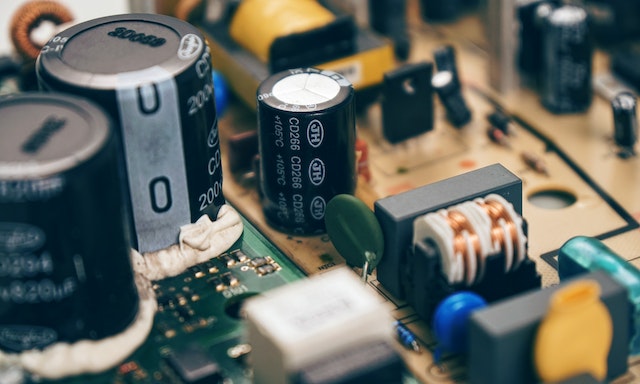Understanding Indium Phosphide: An Overview
Indium Phosphide (InP), a duo-semiconductor born from the union of indium and phosphorus, has been thrust into prominence within the optoelectronics arena. The reason behind this heightened interest? Its superior traits when juxtaposed with silicon, especially in relation to photonic integrated circuits. InP’s crystal structure boasts a direct band gap – an attribute that positions it as the ideal candidate for optical applications such as lasers and photodetectors.

As we delve deeper into InP’s use in creating optoelectronic devices, its singular characteristics come to light – qualities that make it particularly amenable for this purpose. One critical feature lies in its capacity to act as an exemplar substrate for epitaxial growth of other semiconductors. This capability paves the way for high-performance multilayer structures pivotal in advanced optoelectronic devices. Additionally, when compared to silicon, InP claims higher electron velocity making it speedier – an essential consideration when dealing with components like transistors embedded within electronic circuits.
The focus then veers towards Indium Phosphide Photonic Integrated Circuits (InP PICs). Essentially microchips that have replaced electrons with photons – these are a revelation! The advantage here is dual-fold: not just speed but also precision; photons outpace electrons while losing less energy over distances travelled. Thus employing InP PICs becomes a logical step if our goal is devising faster and more energy-lean systems or networks equipped enough to manage vast amounts data transmission devoid loss or delay.
The Composition and Crystal Structure of Indium Phosphide
Bewildering, yet enthralling, is the world of Indium Phosphide – a binary semiconductor depicted by the chemical formula InP. This exotic compound, begotten from indium and phosphorus, has stirred considerable excitement in photonics. Its allure lies in its peculiar traits such as a direct bandgap and an impressive electron mobility.

The crystal configuration of Indium Phosphide echoes that of gallium arsenide – face-centered cubic (FCC). It’s this structure that unlocks an ideal energy gap or bandgap for numerous optoelectronic applications – adding to its irresistible charm.
In the bewitching process of fabrication, you’ll find an indium phosphide wafer masquerading as a substrate. Upon it are deposited layers which metamorphose into photonic integrated circuits (PICs). Swapping traditional silicon substrates with these wafers supercharges PIC performance with speed and efficiency like no other. The secret behind achieving coveted optical properties? High-quality InP wafers!
Doping dances centre stage when manipulating electrical characteristics within semiconductors akin to Indium Phosphide. Tinkering with impurities inside the crystalline structure allows one to masterfully puppeteer conductivity type and level within this material; better tailoring it for specific applications nestled within photonics technology development.
In comparison to silicon-based devices, those built on the complex platform offered by indium phosphide can operate at elevated frequencies consuming less power – factors driving their widespread adoption across various sectors including telecommunications and data centres.
Silicon vs Indium Phosphide: A Comparative Analysis
Lost in the labyrinth of semiconductor fabrication, we find ourselves grappling with two key protagonists – Silicon and Indium Phosphide (InP). They’re akin to chess pieces on the board of technology; each possessing distinctive traits that make them ideal for particular niches.
Silicon has claimed its throne as the monarch of semiconductors, backed by its sterling electrical attributes and unwavering thermal stability. It’s often seen playing a pivotal role in an array of electronic devices like transistors, diodes, and integrated circuits donned as silicon wafers.
However, when photons come into play – under the umbrella term ‘photonics’ entailing light generation, detection and manipulation – it’s InP that steals the limelight due to its unrivaled characteristics.
Indium phosphide sports a direct band gap badge which qualifies it perfectly for optoelectronic applications where light emission or absorption takes place such as lasers and photodetectors. This trait enables InP-based devices to perform at greater frequencies outshining their silicon rivals – a blessing for high-speed photonic integrated circuits.
The optical prowess flaunted by indium phosphide is absolutely crucial in wielding quantum effects where individual photons can be played around with ushering advancements in quantum computing landscape.
A noteworthy feature within InP is its superior electron mobility compared to silicon resulting in swift switching times; this further fortifies InP’s standing within fast-paced electronics and photonics domains. Furthermore, thanks to indium phosphide wafers having lattice constants almost identical to certain compound semiconductors like Gallium Arsenide (GaAs), they can effortlessly host these substances on their surfaces leading towards highly productive multi-junction solar cells among other marvels.
But while celebrating these boons one must not overlook practical aspects such as cost effectiveness since despite all odds silicon remains more economical than InP yet providing dependable performance across diverse sectors.
The Role of Indium Phosphide in the Fabrication of Optoelectronic Devices
Amidst the myriad compound semiconductors, Indium Phosphide (InP) has carved its niche in the fabrication realm of optoelectronic devices, all thanks to its intriguingly unique properties. The direct band gap it boasts of is a game-changer – enabling efficient light emission and absorption – an indispensable feature for optoelectronics. This alone isn’t what sets it apart; its lattice constant goes hand in glove with that of indium gallium arsenide (InGaAs), making InP an ideal stage for epitaxial growth of InGaAs-based units such as high-velocity modulators and photodetectors.
Indium Phosphide’s applications are far-flung from diodes to solar cells, with each contraption capitalizing on different facets of this multi-dimensional material. Consider diodes; they drink up InP’s high electron mobility which opens gates for carrier transport at thundering speeds. Such a trait predestines them for use in fast-switching domains like integrated photonics where velocity reigns supreme. Divergently, solar cells tap into InP’s direct bandgap prowess leading to superior sunlight absorption outshining silicon or even gallium arsenide.
Moreover, the etch characteristics held by Indium Phosphide cooperate seamlessly with precise fabrication processes required to craft intricate structures essential in advanced opto-electronic devices. When compared against materials like gallium arsenide or silicon, InP stands tall exhibiting less damage during dry etching procedures – a boon when evolving complex nanostructures within dimensions measuring 100 nm or less.
Thus, through myriad attributes including harmonious lattice constants with selective III-V semiconductors and exceptional physical characteristics linked with its direct band structure combined favorably processing traits; Indium phosphide continues holding sway over cutting-edge optoelectronics technology development without batting an eyelid.
Indium Phosphide Wafers: Importance in Photonic Integrated Circuits
In the dynamic world of photonic integrated circuits, Indium phosphide (InP) wafers hold a notable place due to their distinctive characteristics and crystalline composition. The high electron velocity and mobility that typify this semiconductor material render it an idyllic base for optoelectronic contrivances such as laser diodes functioning at certain wavelengths. Notably, the InP substrate showcases a low density which augments its effectiveness in fabricating lightweight electronic devices.
A key feature of InP’s unique makeup is its direct bandgap, which facilitates efficient light emission – an attribute highly valued in sensors and other optoelectronics. The process employed to manufacture these peculiarly useful InP wafers incorporates multiple steps including epitaxial growth and doping; each essential in achieving superior quality.
Epitaxial growth ensures the creation of prime-quality InP layers on wafer surfaces while through doping impurities are intentionally incorporated into the semiconductor material to tweak its electrical properties as per requirement. For instance, introducing certain elements can enhance current density or adjust conductivity levels within transistors constructed upon these substrates.
One intriguing aspect of Indium Phosphide is its natural oxide layer that affords excellent passivation qualities safeguarding underlying tiers from environmental factors thereby boosting device longevity.
Beyond serving as substrates for laser diodes operating at telecommunications wavelengths, indium phosphide wafers often form partnerships with indium gallium arsenide (InGaAs), another compound semiconductor noted for infrared light sensitivity. This partnership performs exceptionally well in RF applications due to inherent fast-switching capabilities surpassing silicon-based materials typically engaged within this realm.
Understanding thusly the pivotal role inhabited by Indium Phosphide within photonic integrated circuits unveils how this extraordinary compound keeps influencing progressions throughout diverse electronics technology sectors.
The Direct Band Gap of Indium Phosphide: Significance in Optics
The enigma of Indium Phosphide’s direct band gap holds enormous significance in the world of optics, most notably within optical communication. This intriguing compound semiconductor boasts an electronic band structure that permits it to emit light proficiently when electrified – a feature that earmarks it for utilization in photonic integrated circuits and semiconductor optical amplifiers. The rapid electron velocity connected with Indium Phosphide further enhances its prowess as a band gap semiconductor, enabling swifter data transmission rates through optical fibers.
At Eindhoven University of Technology, scholars have been at the heart of probing into the expansion of InP (Indium Phosphide) and exploring its potential uses. Their research has centered around evolving methods to fabricate InP nanowires (InP NWs), which hold promise in building photonic crystals. These structures provide extraordinary optical confinement features, permitting precise manipulation of light within indium phosphide photonic integrated circuits. By incorporating these InP NWs into an indium phosphide wafer, they’ve succeeded in formulating highly efficient quantum wells – regions where electrons are held captive in three dimensions and can only journey along one axis.
Utilizing scanning electron microscopy has unearthed captivating details about this material’s crystal structure – revealing insights into why it excels as a direct bandgap semiconductor. It is evident that the distinct attributes of indium phosphide make it irreplaceable for forthcoming progressions in optic technology fields such as high-speed photonics devices or even succeeding generation internet infrastructure grounded on fiber optics communications systems.
Gallium Arsenide and Indium Phosphide: The Preferred Semiconductors
In the sphere of technological applications, gallium arsenide along with indium phosphide have ascended to preferred semiconductor status. The binary compound of indium phosphide, a combination of indium and phosphorus, is lauded for its multifaceted benefits. Its wide-ranging use in high-velocity photonic apparatus can be attributed to its direct bandgap attributes. As such, the energy chasm inherent in indium phosphide makes it ideally suited for optoelectronic utilizations wherein light emission or absorption is necessitated.
The fabrication methodology employed for these semiconductors typically entails using an InP membrane waveguide laid upon a silicon base. This tactic brings about significant performance efficiency improvement when juxtaposed against conventional silicon photonics. Furthering this point, research published within physica status solidi highlights that when alloyed with elements like indium tin oxide or doped InP, gallium arsenide as another binary semiconductor unveils distinctively superior characteristics.
It’s critical to underscore that both gallium arsenid and indimun phsphite hold pivotal roles in architecting intricate structures such as Indiu Gallum Arsenid Phosphides (InGaAsP). These constructions are integral components in fiber connections where they enable efficient data transmission across expansive distances. Beyond this application area, they also contribute towards creating sturdy semiconductor wafers which act as essential foundational elements for numerous contemporary electronic devices.
The Evolution of Indium Phosphide in High-Speed Photonic Devices
The unfolding narrative of Indium Phosphide (InP) semiconductors in the orchestra of high-speed photonic devices is truly compelling. It’s their unique attributes like direct bandgap and superior electron mobility that have played a key role- all decidedly advantageous for optoelectronic applications. The canvas for InP usage has seen an impressive expansion, with its versatile application spanning from semiconductor quantum dots to bulk InP deployed in manufacturing various advanced components.
No less captivating is the pivotal part single InP plays within these cutting-edge technologies. Of all available materials, it proudly sports the longest wavelength sensitivity range – effectively making it a prime pick for long-distance telecommunication systems. That’s not all; Photonic Integrated Circuits (PICs), often christened as ‘InP PICs’, smartly utilize this material’s assets to coalesce multiple photonic functions into one compact device. Such circuits are synonymous with enhanced performance, size reduction, cost-effectiveness and augmented reliability.
Treading further on this path of innovation brings us to another significant breakthrough in nanotechnology where Indium Phosphide forms an indispensable element – aptly termed as ‘InP core’. This technology taps into the extraordinary optical properties of InP material at nano-scale dimensions offering more efficient light emission than conventional materials can ever promise. As research deepens our understanding about this remarkable semiconductor crystal continues to grow exponentially, we’re looking forward to wider adoption and even more ingenious uses across diverse sectors including telecommunications and healthcare diagnostics among others.




Comments are closed.